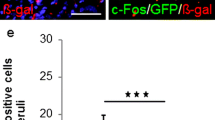Abstract
A continuous chemosensory monitoring of the ingested food is of vital importance for adjusting digestive processes according to diet composition. Although any dysfunction of this surveillance system may be the cause of severe gastrointestinal disorders, information about the cellular and molecular basis of chemosensation in the gastrointestinal tract is limited. The porcine alimentary canal is considered as an appropriate model for the human gastrointestinal tract. Therefore, in this study we have investigated the gastric mucosa of swine for cells which express gustatory transduction elements such as TRPM5 or PLCβ2, and thus may represent candidate “chemosensors”. It was found that the porcine stomach indeed contains cells expressing gustatory marker molecules; however, the morphology and topographic distribution of putative chemosensory cells varied significantly from that in mice. Whereas in the murine stomach these cells were clustered at a distinct region near the gastric entrance, no such compact cell cluster was found in the pig stomach. These results indicate substantial differences regarding the phenotype of candidate chemosensory cells of mice and swine and underline the importance of choosing the most suitable model organisms.





Similar content being viewed by others
References
Bezençon C, le Coutre J, Damak S (2007) Taste-signaling proteins are coexpressed in solitary intestinal epithelial cells. Chem Senses 32(1):41–49
Book SA, Bustad LK (1974) The fetal and neonatal pig in biomedical research. J Anim Sci 38(5):997–1002
Debas HT (1987) Gastrin. Clin Invest Med 10(3):222–225
Furness JB (2008) The enteric nervous system: normal functions and enteric neuropathies. Neurogastroenterol Motil 20(Suppl 1):32–38
Graves HB (1984) Behaviour and ecology of wild and feral swine (Sus scrofa). J Anim Sci 58:482–492
Grube D (1986) The endocrine cells of the digestive system: amines, peptides, and modes of action. Anat Embryol (Berl) 175(2):151–162
Guilloteau P, Zabielski R, Hammon HM, Metges CC (2010) Nutritional programming of gastrointestinal tract development. Is the pig a good model for man? Nutr Res Rev 23(1):4–22
Hass N, Schwarzenbacher K, Breer H (2007) A cluster of gustducin-expressing cells in the mouse stomach associated with two distinct populations of enteroendocrine cells. Histochem Cell Biol 128(5):457–471
Hass N, Schwarzenbacher K, Breer H (2010) T1R3 is expressed in brush cells and ghrelin-producing cells of murine stomach. Cell Tissue Res 339(3):493–504
He W, Yasumatsu K, Varadarajan V, Yamada A, Lem J, Ninomiya Y, Margolskee RF, Damak S (2004) Umami taste responses are mediated by alpha-transducin and alpha-gustducin. J Neurosci 24(35):7674–7680
Höfer D, Püschel B, Drenckhahn D (1996) Taste receptor-like cells in the rat gut identified by expression of alpha-gustducin. Proc Natl Acad Sci USA 93(13):6631–6634
Houpt KA, Houpt TR, Pond WG (1979) The pig as a model for the study of obesity and of control of food intake: a review. Yale J Biol Med 52(3):307–329
Kararli TT (1995) Comparison of the gastrointestinal anatomy, physiology and biochemistry of humans and commonly used laboratory animals. Biopharm Drug Dispos 16(5):351–380
Kaske S, Krasteva G, König P, Kummer W, Hofmann T, Gudermann T, Chubanov V (2007) TRPM5, a taste-signaling transient receptor potential ion-channel, is a ubiquitous signaling component in chemosensory cells. BMC Neurosci 8:49
König H, Liebich H (2003) Anatomie der Haussäugetiere, 4th edn. Schattauer, Stuttgart
Mackintosh CE, Kreel L (1977) Anatomy and radiology of the areae gastricae. Gut 18(11):855–864
Miller ER, Ullrey DE (1987) The pig as a model for human nutrition. Annu Rev Nutr 7:361–382
Nelson G, Hoon MA, Chandrashekar J, Zhang Y, Ryba NJ, Zuker CS (2001) Mammalian sweet taste receptors. Cell 106(3):381–390
Nelson G, Chandrashekar J, Hoon MA, Feng L, Zhao G, Ryba NJ, Zuker CS (2002) An amino-acid taste receptor. Nature 14;416(6877):199–202
Nickel R, Schummer A, Seiferle E (2003) Lehrbuch der Anatomie der Haustiere, Band II: Eingeweide, 8th edn. Parey at WVS, Stuttgart
Ormsbee HS 3rd, Fondacaro JD (1985) Action of serotonin on the gastrointestinal tract. Proc Soc Exp Biol Med 178(3):333–338
Pond WG, Houpt KA (eds) (1978) The biology of the pig. Cornell University Press, Ithaca
Rowan AM, Moughan PJ, Wilson MN, Maher K, Tasman-Jones C (1994) Comparison of the ileal and faecal digestibility of dietary amino acids in adult humans and evaluation of the pig as a model animal for digestion studies in man. Br J Nutr 71(1):29–42
Shulman RJ (1993) The piglet can be used to study the effects of parenteral and enteral nutrition on body composition. J Nutr 123(2 Suppl):395–398
Wattel W, Geuze JJ (1978) The cells of the rat gastric groove and cardia. An ultrastructural and carbohydrate histochemical study, with special reference to the fibrillovesicular cells. Cell Tissue Res 186(3):375–391
Wong GT, Gannon KS, Margolskee RF (1996) Transduction of bitter and sweet taste by gustducin. Nature 27;381(6585):796–800
Acknowledgments
The authors thank Kerstin Bach for excellent technical assistance as well as Laura Schlosser and Sofia Hirth for their valuable contributions to this study. We are also much obliged to T. Gudermann and V. Chubanov for generously providing the TRPM5 antibody. This work was supported by the “Kompetenznetz Adipositas (Competence Network of Obesity)”, research focus “Obesity and the GI tract”, funded by the Federal Ministry of Education and Research (No. 01GI0843). Nicole Hass is a recipient of a Peter und Traudl Engelhorn Stiftung scholarship.
Author information
Authors and Affiliations
Corresponding authors
Rights and permissions
About this article
Cite this article
Widmayer, P., Breer, H. & Hass, N. Candidate chemosensory cells in the porcine stomach. Histochem Cell Biol 136, 37–45 (2011). https://doi.org/10.1007/s00418-011-0824-0
Accepted:
Published:
Issue Date:
DOI: https://doi.org/10.1007/s00418-011-0824-0




